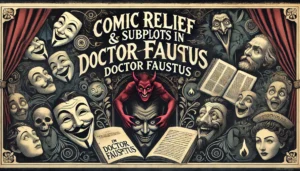Tradition of Revenge Tragedy in Hamlet
Revenge tragedy was one of the most popular genres in Elizabethan and Jacobean drama, and Hamlet is often considered its finest example. Shakespeare’s play follows many conventions of the revenge tragedy tradition, particularly those influenced by the Roman playwright Seneca. However, Hamlet also departs from typical revenge plays by adding psychological depth and philosophical complexity. This article explores the Senecan influences in Hamlet and compares it with other well-known revenge tragedies focusing the tradition of revenge tragedy in Hamlet.

Senecan Influences on Hamlet
The revenge tragedy tradition originates from Seneca, a Roman playwright and philosopher of the 1st century AD. His tragedies, such as Thyestes and Hercules Furens, were known for their:
- A vengeful ghost urging retaliation.
- A delay in revenge, often due to the protagonist’s internal struggle.
- Soliloquies expressing deep emotions and conflicts.
- Violence and bloodshed, often described rather than shown on stage.
Shakespeare draws from these elements in Hamlet:
- The ghost of King Hamlet appears, demanding revenge:
“Revenge his foul and most unnatural murder.” (Act 1, Scene 5)
- Hamlet delays his revenge, struggling with doubt and morality.
- The play is rich in soliloquies, where Hamlet expresses his inner turmoil.
However, Shakespeare departs from Senecan tragedy by adding depth to Hamlet’s character, making him more than a simple avenger.

Comparison with Other Revenge Tragedies
1. The Spanish Tragedy (1587) by Thomas Kyd
Often considered the first true Elizabethan revenge play, The Spanish Tragedy heavily influenced Hamlet. Both plays feature:
- A ghost calling for revenge.
- A hesitant protagonist torn between action and inaction.
- The use of a play-within-a-play to expose a murderer.
However, while Kyd’s Hieronimo is driven by emotional fury, Hamlet is more philosophical and introspective, questioning the very nature of revenge.
2. Titus Andronicus (1594) by Shakespeare
Shakespeare’s earlier tragedy Titus Andronicus follows a more violent and straightforward path of revenge. Unlike Hamlet, which focuses on psychological struggle, Titus Andronicus is filled with graphic violence and brutal retribution. This reflects the influence of Senecan horror and bloodshed.
3. The Revenger’s Tragedy (1606) by Thomas Middleton
This later revenge play features a protagonist, Vindice, who—unlike Hamlet—immediately seeks vengeance. The play satirizes the moral corruption of the court, similar to the rotting state of Denmark in Hamlet:
“Something is rotten in the state of Denmark.” (Act 1, Scene 4)
While The Revenger’s Tragedy is darkly comic, Hamlet is a deeper meditation on fate, morality, and justice.
How Hamlet Transforms the Revenge Tragedy
Shakespeare elevates the revenge tragedy genre by making Hamlet a thinking, conflicted protagonist. Instead of blindly seeking vengeance, he contemplates the nature of life, death, and justice. This makes Hamlet a more philosophical and psychological tragedy rather than just a tale of retribution.
#Tradition of revenge tragedy in Hamlet #Tradition of revenge tragedy in Hamlet #Tradition of revenge tragedy in Hamlet #Tradition of revenge tragedy in Hamlet #Tradition of revenge tragedy in Hamlet #Tradition of revenge tragedy in Hamlet #Tradition of revenge tragedy in Hamlet #Tradition of revenge tragedy in Hamlet
Read More
Introduction to Hamlet and Shakespeare
Legacy and Themes of Doctor Faustus
Comic Relief & Subplots in Doctor Faustus
The Role of Mephistopheles and the Devil Pact in Dr Faustus
Introduction to Dr Faustus and Marlowe
Classical Theatre and Classical Drama
Plot Construction in Pride and Prejudice
Introduction to Fiction and Non Fiction
Of Death — Francis Bacon (Text)
Of Truth Critical Analysis by Sir Francis Bacon
Of Truth by Francis Bacon Summary
Visit Us on our Facebook Page:






